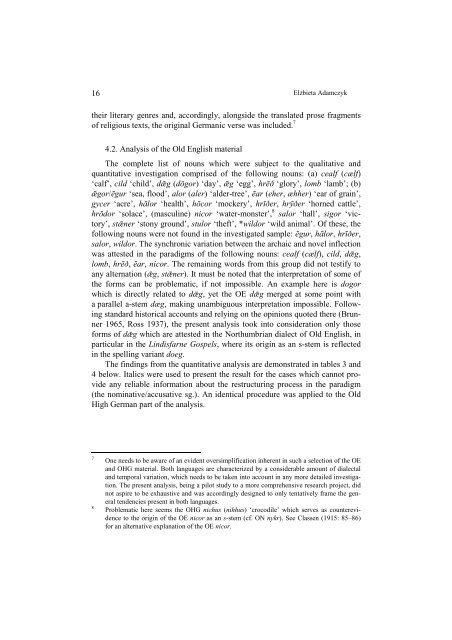s - Wyższa SzkoÅa Filologiczna we WrocÅawiu
s - Wyższa SzkoÅa Filologiczna we WrocÅawiu
s - Wyższa SzkoÅa Filologiczna we WrocÅawiu
Create successful ePaper yourself
Turn your PDF publications into a flip-book with our unique Google optimized e-Paper software.
16<br />
Elżbieta Adamczyk<br />
their literary genres and, accordingly, alongside the translated prose fragments<br />
of religious texts, the original Germanic verse was included. 7<br />
4.2. Analysis of the Old English material<br />
The complete list of nouns which <strong>we</strong>re subject to the qualitative and<br />
quantitative investigation comprised of the following nouns: (a) cealf (cælf)<br />
‘calf’, cild ‘child’, dǣg (dōgor) ‘day’, ǣg ‘egg’, hrēð ‘glory’, lomb ‘lamb’; (b)<br />
ǣgor/ēgur ‘sea, flood’, alor (aler) ‘alder-tree’, ēar (eher, æhher) ‘ear of grain’,<br />
gycer ‘acre’, hālor ‘health’, hōcor ‘mockery’, hrīðer, hrȳðer ‘horned cattle’,<br />
hrōdor ‘solace’, (masculine) nicor ‘water-monster’, 8 salor ‘hall’, sigor ‘victory’,<br />
stǣner ‘stony ground’, stulor ‘theft’, *wildor ‘wild animal’. Of these, the<br />
following nouns <strong>we</strong>re not found in the investigated sample: ēgur, hālor, hrīðer,<br />
salor, wildor. The synchronic variation bet<strong>we</strong>en the archaic and novel inflection<br />
was attested in the paradigms of the following nouns: cealf (cælf), cild, dǣg,<br />
lomb, hrēð, ēar, nicor. The remaining words from this group did not testify to<br />
any alternation (ǣg, stǣner). It must be noted that the interpretation of some of<br />
the forms can be problematic, if not impossible. An example here is dogor<br />
which is directly related to dǣg, yet the OE dǣg merged at some point with<br />
a parallel a-stem dæg, making unambiguous interpretation impossible. Following<br />
standard historical accounts and relying on the opinions quoted there (Brunner<br />
1965, Ross 1937), the present analysis took into consideration only those<br />
forms of dǣg which are attested in the Northumbrian dialect of Old English, in<br />
particular in the Lindisfarne Gospels, where its origin as an s-stem is reflected<br />
in the spelling variant doeg.<br />
The findings from the quantitative analysis are demonstrated in tables 3 and<br />
4 below. Italics <strong>we</strong>re used to present the result for the cases which cannot provide<br />
any reliable information about the restructuring process in the paradigm<br />
(the nominative/accusative sg.). An identical procedure was applied to the Old<br />
High German part of the analysis.<br />
7<br />
8<br />
One needs to be aware of an evident oversimplification inherent in such a selection of the OE<br />
and OHG material. Both languages are characterized by a considerable amount of dialectal<br />
and temporal variation, which needs to be taken into account in any more detailed investigation.<br />
The present analysis, being a pilot study to a more comprehensive research project, did<br />
not aspire to be exhaustive and was accordingly designed to only tentatively frame the general<br />
tendencies present in both languages.<br />
Problematic here seems the OHG nichus (nihhus) ‘crocodile’ which serves as counterevidence<br />
to the origin of the OE nicor as an s-stem (cf. ON nykr). See Classen (1915: 85–86)<br />
for an alternative explanation of the OE nicor.
















